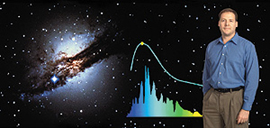NERSC's Peter Nugent Named to Hubble Space Telescope Users Committee
March 4, 2002
Peter Nugent, an astrophysicist in NERSC's Scientific Computing Group who made news last year as co-discoverer of the oldest supernova ever found, has been asked to join the Hubble Space Telescope Users Committee. The committee is an international panel of 12 scientists who serve for three years.

Peter Nugent
"Most of the others that sit on this committee have been full professors for quite some time, therefore I was a little surprised they asked me," Nugent said. "The committee members represent the several thousand PIs and co-investigators who use the Hubble Space Telescope. I have a feeling that since I work with almost everyone in the supernova astrophysics community easily, I could represent a fairly broad perspective of users."
The committee advises the Space Telescope Science Institute and NASA, from the users' perspective, on the normal operations of the Hubble Space Telescope, and recommend changes and improvements to both instrumentation and procedures in order to maximize scientific productivity.
Currently in the second year of a two-year Hubble Space Telescope grant and the first year of a long-term NASA Space Astrophysics grant, Nugent joined NERSC last year after four years as a post-doc in the Lab's Physics Division to help strengthen the computational astrophysics activity at NERSC.
He previously worked with Saul Perlmutter's Supernova Cosmology Project and used NERSC's Cray T3E and IBM SP supercomputers to perform thousands of supernova simulations. As the theorist in Perlmutter's group, Nugent conducted "spectrum synthesis," starting with a theory of an exploding supernova to create a theoretical spectrum and then comparing that model with observed data. The goal of the work is to make supernovae a better tool for cosmology. Nugent earned his Ph.D. in physics, with a concentration in astronomy, from the University of Oklahoma.
Read more about his supernova research at http://www.lbl.gov/CS/Archive/headlines04-02-01.html and http://www.lbl.gov/CS/Archive/headlines1-4-99.html.
More information about the Hubble Space Telescope Users Committee can be found at http://www.stsci.edu/stsci/STUC/.
About NERSC and Berkeley Lab
The National Energy Research Scientific Computing Center (NERSC) is a U.S. Department of Energy Office of Science User Facility that serves as the primary high performance computing center for scientific research sponsored by the Office of Science. Located at Lawrence Berkeley National Laboratory, NERSC serves almost 10,000 scientists at national laboratories and universities researching a wide range of problems in climate, fusion energy, materials science, physics, chemistry, computational biology, and other disciplines. Berkeley Lab is a DOE national laboratory located in Berkeley, California. It conducts unclassified scientific research and is managed by the University of California for the U.S. Department of Energy. »Learn more about computing sciences at Berkeley Lab.







